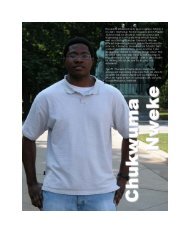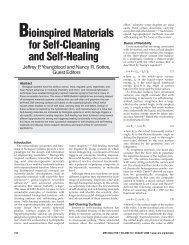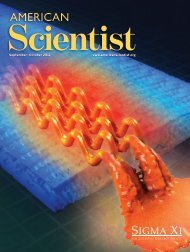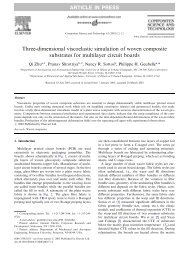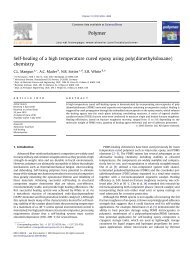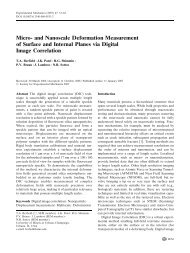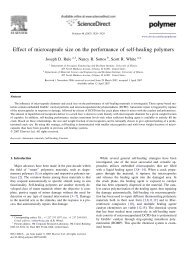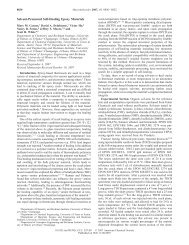Alicia Tosdal - Sottos Research Group - University of Illinois at ...
Alicia Tosdal - Sottos Research Group - University of Illinois at ...
Alicia Tosdal - Sottos Research Group - University of Illinois at ...
You also want an ePaper? Increase the reach of your titles
YUMPU automatically turns print PDFs into web optimized ePapers that Google loves.
Center for Nanoscale Chemical-Electrical-Mechanical Manufacturing Systems<br />
Directed Printing <strong>of</strong> Self-Healing<br />
Capsules through Dielectrophoretic<br />
Force<br />
Undergradu<strong>at</strong>e <strong>Research</strong>er<br />
<strong>Alicia</strong> <strong>Tosdal</strong>, <strong>Research</strong><br />
Experience for Undergradu<strong>at</strong>es<br />
(REU), Georgia Institute <strong>of</strong><br />
Technology<br />
Faculty Mentor<br />
Pr<strong>of</strong>essor Nancy R. <strong>Sottos</strong>,<br />
Department <strong>of</strong> Mechanical<br />
Science and Engineering,<br />
<strong>University</strong> <strong>of</strong> <strong>Illinois</strong> <strong>at</strong> Urbana-<br />
Champaign<br />
Gradu<strong>at</strong>e Student Mentor<br />
Jinglei Yang, Beckman Institute<br />
for Advanced Science and<br />
Technology, <strong>University</strong> <strong>of</strong><br />
<strong>Illinois</strong> <strong>at</strong> Urbana-Champaign<br />
Abstract<br />
Dielectrophoretic force applied<br />
by a non-uniform electric field<br />
over the sample manipul<strong>at</strong>es<br />
self-healing capsules into a<br />
distinct monolayer. Suspended<br />
in distilled w<strong>at</strong>er with controlled<br />
pH levels, long chains form. The<br />
chains form on the lowest level,<br />
spanning the shortest distance<br />
between the two electrodes.<br />
Capsule concentr<strong>at</strong>ion by weight<br />
<strong>of</strong> less than 2wt% has been<br />
shown to produce chains<br />
spanning the electrodes under an<br />
altern<strong>at</strong>ing field <strong>of</strong> 75V/cm with<br />
a frequency <strong>of</strong> 5kHz. Averaging<br />
2.1μm, the chains cure in<br />
proportion to the diameter <strong>of</strong> the<br />
various capsules in the chain.<br />
When suspended in polymer,<br />
dispersion is difficult due to the<br />
increased viscosity. The<br />
nanocapsules form large<br />
aggreg<strong>at</strong>es instead <strong>of</strong> dispersing<br />
as individual capsules. The<br />
capsules chain within the<br />
aggreg<strong>at</strong>es as a result.<br />
Introduction and<br />
Background<br />
Self-healing with<br />
dicyclopentadiene (hereafter<br />
DCPD) occurs via ring-opening<br />
met<strong>at</strong>hesis, a chemical reaction<br />
th<strong>at</strong> allows mass polymeriz<strong>at</strong>ion<br />
in the presences <strong>of</strong> a c<strong>at</strong>alyst.<br />
DCPD, encapsul<strong>at</strong>ed with poly<br />
(urea-formaldehyde) by in situ<br />
oil-in-w<strong>at</strong>er-emulsion reactions,<br />
is an organic monomer with two<br />
different conform<strong>at</strong>ional<br />
isomers. Exo-DCPD is the more<br />
reactive <strong>of</strong> the two isomers, but<br />
endo-DCPD is altern<strong>at</strong>ively<br />
more stable. Likewise, while the<br />
exo isomer makes non-uniform<br />
shell walls, the endo isomer<br />
gener<strong>at</strong>es more uniform shell<br />
wall thickness. Because <strong>of</strong> the<br />
instability <strong>of</strong> the exo-DCPD, the<br />
resulting capsule shells form<br />
irregular spheres. As seen in<br />
Figure 1, the shell wall is nonuniform<br />
in shape and <strong>of</strong>ten has<br />
irregularities in thickness,<br />
causing leakage. While the exo<br />
isomer is more reactive, it exists<br />
in significantly smaller<br />
quantities than endo-DCPD. As<br />
a result, use <strong>of</strong> the endo isomer<br />
is more prevalent. The<br />
encapsul<strong>at</strong>ed microcapsules <strong>of</strong><br />
DCPD are suspended in an<br />
epoxy m<strong>at</strong>rix with the c<strong>at</strong>alyst.<br />
The c<strong>at</strong>alyst used for the<br />
reaction is Grubb’s c<strong>at</strong>alyst. In<br />
the case th<strong>at</strong> the epoxy m<strong>at</strong>rix is<br />
cracked, the crack may breach<br />
the shell <strong>of</strong> a capsule. As the<br />
crack propag<strong>at</strong>es through the<br />
epoxy, the dicyclopentadiene<br />
leaks from the cracked shell and<br />
reacts upon contact with the<br />
Grubb’s c<strong>at</strong>alyst. This reaction<br />
fills the crack gener<strong>at</strong>ed in the<br />
epoxy m<strong>at</strong>rix and promotes selfhealing.<br />
1<br />
When the capsules are<br />
suspended in the epoxy m<strong>at</strong>rix,<br />
they are rarely suspended<br />
uniformly. This non-uniform<br />
dispersion leads to unequal<br />
healing in the event th<strong>at</strong> cracks<br />
appear under stress. Capsules<br />
<strong>of</strong>ten appear as aggreg<strong>at</strong>es in the<br />
epoxy. When studied under an<br />
electric field, silica particles<br />
with a diameter <strong>of</strong> 1μm have<br />
been found to form a uniform<br />
monolayer. 2 This monolayer is<br />
formed through<br />
dielectrophoresis (DEP), more<br />
specifically dielectrophoretic<br />
force. DEP force is a force<br />
exerted specifically on a<br />
dielectric particle when it is<br />
subjected to a non-uniform<br />
electric field. DEP force does<br />
not require the particle to be<br />
charged. In the case <strong>of</strong> the<br />
encapsul<strong>at</strong>ed DCPD, the<br />
microcapsules carry a net<br />
neutral charge. Under the nonuniform<br />
field, however, the<br />
capsules undergo a net dipole<br />
moment. The dipole moment<br />
causes one side <strong>of</strong> the capsule to<br />
gain a positive charge facing the





